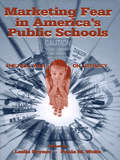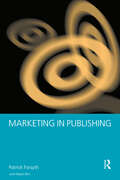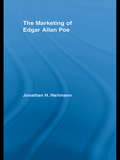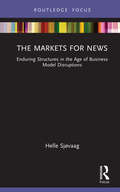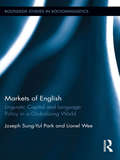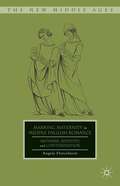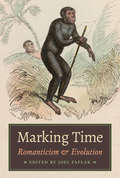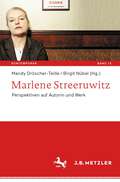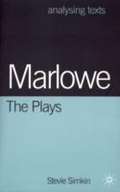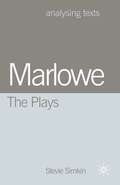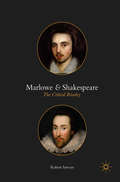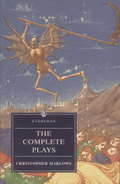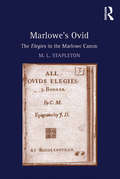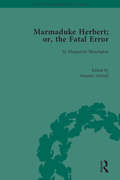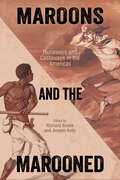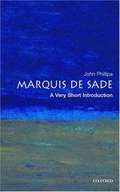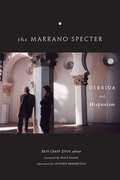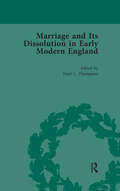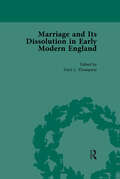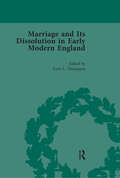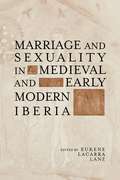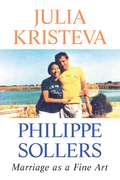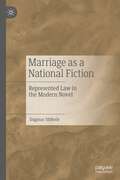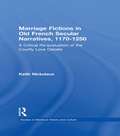- Table View
- List View
Marketing Fear in America's Public Schools: The Real War on Literacy
by Leslie Poynor Paula M. WolfeMarketing Fear in America's Public Schools: The Real War on Literacy is an eye-opening examination of the real world consequences of the political pressures and influences on teachers today. In particular, it looks at how the political actions of the conservative right disempower and control teachers, school districts, parents, and children through an atmosphere of fear used as a strategy to ensure that schools follow the conservative political agenda supporting and imposing mandates such as increased accountability, high stakes testing, and direct intense direct-instruction phonics programs. The book offers a unique look not at not only what the conservative factions are doing but why. The volume includes chapters on: *resistance to the conservative agenda; *national and/or federal agendas and actions that directly or indirectly contribute to the privatization and corporate control of public education; *the linkage of federal policy to the disappearance or promotion of particular philosophical and pedagogical approaches; and *the role of the media in perpetuating the agendas of the corporate and political right. Many teachers across the U.S. are frustrated and angry about the outside legislative constraints placed on their work, but at the same time frightened of losing their jobs and/or being faced with a lawsuit. The book's premise is that one must understand the motives behind the current educational "reforms" in order to resist them. The editors and contributors envision the volume as a voice for an alternative to compliance with unreasonable mandates--and thus as a message of hope. Marketing Fear in America's Public Schools: The Real War on Literacy is important reading for teachers; teacher educators; education students; school administrators and other education professionals; researchers concerned with literacy, critical theory, pedagogy, and educational policy; and parents and community activists concerned with the politics of schooling and school reform. It is will serve well as a text in a range of courses across the field of education. A Web site for the book can be found at http://www.erlbaum.com/poynor.
Marketing in Publishing (Blueprint Ser.)
by Patrick Forsyth Robin BirnMarketing in Publishing, offers a wealth of practical information on creative strategies to increase book sales in a competitive and rapidly-changing marketplace. It is the first comprehensive study in this area to be published since the ending of the Net Book Agreement.Patrick Forsyth, now a marketing consultant, draws in his many years' experience of the publishing industry to reinstate marketing firmly where it should be: as an integral and integrated part of the whole marketing process.Marketing in Publishing gives expert guidance on different elements of the marketing process, including advice on promotional and direct mail options, and a step-by-step section on how to make an effective sales call. It includes a valuable discussion of fusing market research intelligently to identify new opportunities and market niches. The book also features an authoritative chapter evaluating the importance of electronic publishing.Completely up-to-date, Marketing in Publishing will be essential reading both for those working in marketing and editorial departments, and for students of publishing studies.
The Marketing of Edgar Allan Poe (Studies in American Popular History and Culture)
by Jonathan HartmannEdgar Allan Poe is today considered one of the greatest masters and most fascinating figures of the American literary world. However, an examination of Poe's essays and criticism throughout his prose publishing career (1831-1849) reveals that the author himself played a vital role in the creation and manipulation of his own reputation. During his twenties and thirties, Poe promoted his writing to magazine editors in the United States and in Europe through several strategies. He painted a Romantic and patriotic self-portrait in his fiery literary reviews, even as he played up his own connections, both real and imaginary, to literary celebrities including Washington Irving, Charles Dickens, George Gordon Lord Byron and Samuel Taylor Coleridge. Through recycling plots, atmosphere, and language (including his own) from American and British magazines, he built stories and essays which were linked in a complex network of references to each other and their author. Teachers and students alike will enjoy this single-volume treatment of Poe’s self-promotional tales and criticism.
The Markets for News: Enduring Structures in the Age of Business Model Disruptions (Disruptions)
by Helle SjøvaagIn the face of ongoing digitisation, The Markets for News examines how certain established economic features of the news industry have persisted and what makes them such stable frameworks for journalistic organisations. Drawing on an analysis of Scandinavian news industries, this text revises journalism’s economic foundations in the context of the algorithmically driven platform economy. Exploration of features such as journalism’s two-sided market model, the network effect of platforms, and chain ownership, leads to a discussion about how journalism faces disruption from the introduction of artificial intelligence in the production, dissemination, and sale of news. As journalism undergoes transformations due to revenue losses, this book recognises a return to certain enduring features of journalism’s organisational form, in particular the chain ownership form, that enables scale in adapting to platform logics and economics. This text serves as a basis for a theoretical discussion about strategic media management and critical political economy in the age of digital disruption. This is an insightful book for academics and researchers in the fields of journalism, media industries, media policy and, communication studies.
Markets of English: Linguistic Capital and Language Policy in a Globalizing World (Routledge Studies in Sociolinguistics)
by Joseph Sung-Yul Park Lionel WeeThe global spread of English both reproduces and reinforces oppressive structures of inequality. But such structures can no longer be seen as imposed from an imperial center, as English is now actively adopted and appropriated in local contexts around the world. This book argues that such conditions call for a new critique of global English, one that is sensitive to both the political economic conditions of globalization and speakers’ local practices. Linking Bourdieu’s theory of the linguistic market and his practice-based perspective with recent advances in sociolinguistics and linguistic anthropology, this book offers a fresh new critique of global English. The authors highlight the material, discursive, and semiotic processes through which the value of English in the linguistic market is constructed, and suggest possible policy interventions that may be adopted to address the problems of global English. Through its serious engagement with current sociolinguistic theory and insightful analysis of the multiple dimensions of English in the world, this book challenges the readers to think about what we need to do to confront the social inequalities that are perpetuated by the global spread of English
Marking Maternity In Middle English Romance
by Angela FlorschuetzWorking at the intersection of medical, theological, cultural, and literary studies, this book offers an innovative approach to understanding maternity, genealogy and social identity as they are represented in popular literature in late-medieval England.
Marking Time: Romanticism and Evolution
by Joel FaflakScholars have long studied the impact of Charles Darwin’s writings on nineteenth-century culture. However, few have ventured to examine the precursors to the ideas of Darwin and others in the Romantic period. Marking Time, edited by Joel Faflak, analyses prevailing notions of evolution by tracing its origins to the literary, scientific, and philosophical discourses of the long nineteenth century. The volume’s contributors revisit key developments in the history of evolution prior to The Origin of Species and explore British and European Romanticism’s negotiation between the classic idea of a great immutable chain of being and modern notions of historical change. Marking Time reveals how Romantic and post-Romantic configurations of historical, socio-cultural, scientific, and philosophical transformation continue to exert a profound influence on critical and cultural thought.
Marlene Streeruwitz: Perspektiven auf Autorin und Werk (Kontemporär. Schriften zur deutschsprachigen Gegenwartsliteratur #12)
by Mandy Dröscher-Teille Birgit NübelMarlene Streeruwitz ist eine der streitbarsten politischen Autor*innen der Gegenwart. Literatur ist ihr nicht nur politisches Instrument, sondern als »Modell der Welt in Sprache« zugleich auch ästhetisch autonom. Die Beiträge dieses Bandes diskutieren die Weiterschreibungen, Gegen- und Neukonstruktionen der außertextuellen Welt in den Prosatexten, Essays, Vorlesungen und crossmedialen Projekten der Autorin. In den Blick genommen wird das Welt- und Lebenswissen der Literatur, ihr Beitrag zu unserer Trauer und Resistenz, Erinnerungs- und Überlebensfähigkeit – zwischen Glück, Lust, Liebe, (Für )Sorge und Schmerz. Marlene Streeruwitz trägt – neben einem Gespräch mit den beiden Herausgeberinnen – einen Originalbeitrag sowie einen bisher ungedruckten poetologischen Essay zum Band bei.
Marlowe: The Plays
by Stevie SimkinChristopher Marlowe was the most successful dramatist of his time, his untimely death cutting short a career that may well have rivalled Shakespeare's. His four major works (Doctor Faustus, Edward II, The Jew of Malta and Tamburlaine) are remarkable pieces of theatre, daring explorations of themes such as the nature of kingship, salvation and damnation, sexuality and ethnic prejudice. This book looks in depth at extracts from each of the plays, exploring them in parallel to uncover key concerns, including heroes and anti-heroes, gender and power and politics. As well as guiding readers in an understanding of the place of these issues in their Elizabethan context, and inviting them to consider their resonance today, the book looks in depth at Marlowe's style: his use of rhythm, the complexities and richness of his poetry, and his evolving development of 'character'. Particular attention is given throughout to the plays in performance.
Marlowe: The Plays (Analysing Texts)
by Stevie SimkinChristopher Marlowe was the most successful dramatist of his time, his untimely death cutting short a career that may well have rivalled Shakespeare's. His four major works (Doctor Faustus, Edward II, The Jew of Malta and Tamburlaine) are remarkable pieces of theatre, daring explorations of themes such as the nature of kingship, salvation and damnation, sexuality and ethnic prejudice. This book looks in depth at extracts from each of the plays, exploring them in parallel to uncover key concerns, including heroes and anti-heroes, gender and power and politics.As well as guiding readers in an understanding of the place of these issues in their Elizabethan context, and inviting them to consider their resonance today, the book looks in depth at Marlowe's style: his use of rhythm, the complexities and richness of his poetry, and his evolving development of 'character'. Particular attention is given throughout to the plays in performance.
Marlowe and Shakespeare
by Robert SawyerInstead of asserting any alleged rivalry between Marlowe and Shakespeare, Sawyer examines the literary reception of the two when the writers are placed in tandem during critical discourse or artistic production. Focusing on specific examples from the last 400 years, the study begins with Robert Greene's comments in 1592 and ends with the post-9/11 and 7/7 era. The study not only looks at literary critics and their assessments, but also at playwrights such as Aphra Behn, novelists such as Anthony Burgess, and late twentieth-century movie and theatre directors. The work concludes by showing how the most recent outbreak of Marlowe as Shakespeare's ghostwriter accelerates due to a climate of conspiracy, including "belief echoes," which presently permeate our cultural and critical discourse.
Marlowe: Complete Plays
by Christopher MarloweTheir texts fully restored by recent scholarship, Marlowe's astonishing works can now be appreciated as originally written. For the first time, this edition boasts the complete plays - including two versions of Doctor Faustus.Blasphemy, perversion, defiance and transgression ... in a series of compelling tragedies, Marlowe challenged every authority of heaven and earth. From the proud wrath of Tamburlaine, the tyrant of Asia, to the racked anguish of Edward II, himself in thrall to unspeakable desires; from God's own Machiavel, the Duke of Guise, to Barabas, the Jew of Malta, curse of Christianity: all are taboo-breakers, to be broken in their turn. And in the tragedy of Doctor Faustus we perhaps read Marlowe's own: a tale of brilliance and audacity - and of terrible, inexorable punishment.Their texts fully restored by recent scholarship, Marlowe's astonishing works can now be appreciated as originally written. For the first time, this edition boasts the complete plays - including two versions of Doctor Faustus.
Marlowe's Ovid: The Elegies in the Marlowe Canon
by M. L. StapletonThe first book of its kind, Marlowe's Ovid explores and analyzes in depth the relationship between the Elegies-Marlowe's translation of Ovid's Amores-and Marlowe's own dramatic and poetic works. Stapleton carefully considers Marlowe's Elegies in the context of his seven known dramatic works and his epyllion, Hero and Leander, and offers a different way to read Marlowe. Stapleton employs Marlowe's rendition of the Amores as a way to read his seven dramatic productions and his narrative poetry while engaging with previous scholarship devoted to the accuracy of the translation and to bibliographical issues. The author focuses on four main principles: the intertextual relationship of the Elegies to the rest of the author's canon; its reflection of the influence of Erasmian humanist pedagogy, imitatio and aemulatio; its status as the standard English Amores until the Glorious Revolution, part of the larger phenomenon of pan-European Renaissance Ovidianism; its participation in the genre of the sonnet sequence. He explores how translating the Amores into the Elegies profited Marlowe as a writer, a kind of literary archaeology that explains why he may have commenced such an undertaking. Marlowe's Ovid adds to the body of scholarly work in a number of subfields, including classical influences in English literature, translation, sexuality in literature, early modern poetry and drama, and Marlowe and his milieu.
Marmaduke Herbert; or, the Fatal Error: by Marguerite Blessington (Chawton House Library: Women's Novels)
by Susanne SchmidIn the early and mid-nineteenth century, Marguerite Blessington, who had been born in Ireland but spent most of her life in London, became a famous salonnière; she was generally regarded as an important contemporary author, but as no literary executor took care of her oeuvre posthumously, she eventually moved into the background. Her novels, partly informed by the silver-fork genre, are typical examples of Romantic Victorianism, influenced by the Romantic cult of the solitary male self, by the fascination with Italy, and by the 1840s vogue of crime fiction, while simultaneously giving space to ambivalent reflections about Blessington’s own Irish background. This volume, as part of ‘Chawton House Library: Women’s Novels’ series, presents her 1847 novel Marmaduke Herbert; or, the Fatal Error, a highly popular piece of fiction in its day, being reprinted in German, French and American editions within a year of its publication.
Maroons and the Marooned: Runaways and Castaways in the Americas (Caribbean Studies Series)
by Richard Bodek and Joseph KellyContributions by Richard Bodek, Claire P. Curtis, Joseph Kelly, Simon Lewis, Steve Mentz, J. Brent Morris, Peter Sands, Edward Shore, and James O'Neil Spady Commonly, the word maroon refers to someone cast away on an island. One becomes marooned, usually, through a storm at sea or by a captain as a method of punishment. But the term originally denoted escaped slaves. Though being marooned came to be associated mostly with white European castaways, the etymology invites comparison between true maroons (escaped slaves establishing new lives in the wilderness) and people who were marooned (through maritime disaster). This volume brings together literary scholars with historians, encompassing both literal maroons such as in Brazil and South Carolina as well as metaphoric scenarios in time-travel novels and postapocalyptic narratives. Included are examples from The Tempest; Margaret Atwood’s MaddAddam trilogy; A Connecticut Yankee in King Arthur’s Court; and Octavia Butler’s Kindred. Both runaways and castaways formed new societies in the wilderness. But true maroons, escaped slaves, were not cast away; they chose to fly towards the uncertainties of the wild in pursuit of freedom. In effect, this volume gives these maroons proper credit, at the very heart of American history.
The Marquis de Sade: A Very Short Introduction
by John PhillipsWere it not for the Marquis de Sade's explicit use of language and complete disregard for the artificially constructed taboos of a religious morality he despised, the novelty and profundity of his thought, and above all, its fundamental modernity, would have long since secured him a place alongside the greatest authors and thinkers of the European Enlightenment. This Very Short Introduction aims to disentangle the 'real' Marquis de Sade from his mythical and demonic reputation of the past two hundred years. Phillips examines Sade's life and work: his libertine novels, his championing of atheism, and his uniqueness in bringing the body and sex back into philosophy.
The Marrano Specter: Derrida and Hispanism
by Erin Graff ZivinThe Marrano Specter pursues the reciprocal influence between Jacques Derrida and Hispanism. On the one hand, Derrida’s work has engendered a robust conversation among philosophers and critics in Spain and Latin America, where his work circulates in excellent translation, and where many of the terms and problems he addresses take on a distinctive meaning: nationalism and cosmopolitanism; spectrality and hauntology; the relation of subjectivity and truth; the university; disciplinarity; institutionality.Perhaps more remarkably, the influence is in a profound sense reciprocal: across his writings, Derrida grapples with the theme of marranismo, the phenomenon of Sephardic crypto-Judaism. Derrida’s marranismo is a means of taking apart traditional accounts of identity; a way for Derrida to reflect on the status of the secret; a philosophical nexus where language, nationalism, and truth-telling meet and clash in productive ways; and a way of elaborating a critique of modern biopolitics. It is much more than a simple marker of his work’s Hispanic identity, but it is also, and irreducibly, that.The essays collected in The Marrano Specter cut across the grain of traditional Hispanism, but also of the humanistic disciplines broadly conceived. Their vantage point—the theoretical, philosophically inflected critique of disciplinary practices—poses uncomfortable, often unfamiliar questions for both hispanophone studies and the broader theoretical humanities.
Marriage and Its Dissolution in Early Modern England, Volume 1
by Torri L ThompsonAddresses Early Modern representations of chastity and adultery, as well as matrimony and its dissolution in both the private and public realms, including the most well known marital dissolution, that of Henry VIII and Catherine of Aragon.
Marriage and Its Dissolution in Early Modern England, Volume 2
by Torri L. ThompsonAddresses Early Modern representations of chastity and adultery, as well as matrimony and its dissolution in both the private and public realms, including the most well known marital dissolution, that of Henry VIII and Catherine of Aragon.
Marriage and Its Dissolution in Early Modern England, Volume 3
by Torri L. ThompsonAddresses Early Modern representations of chastity and adultery, as well as matrimony and its dissolution in both the private and public realms, including the most well known marital dissolution, that of Henry VIII and Catherine of Aragon.
Marriage and Its Dissolution in Early Modern England, Volume 4
by Torri L ThompsonAddresses Early Modern representations of chastity and adultery, as well as matrimony and its dissolution in both the private and public realms, including the most well known marital dissolution, that of Henry VIII and Catherine of Aragon.
Marriage and Sexuality in Medieval and Early Modern Iberia (Hispanic Issues #26)
by Eukene Lacarra LanzFirst published in 2002. Routledge is an imprint of Taylor & Francis, an informa company.
Marriage as a Fine Art
by Julia Kristeva Philippe Sollers"We found so much to say, to share, to learn.... For it wasn't just the Marquis de Sade profile and the sporty thighs-and-calves that seduced me. It was even more, perhaps, or certainly just as much, the speed at which you used to read, and still do."—Julia Kristeva"We're married, Julia and I, that's a fact, but we each have our own personalities, our own name, activities, and freedom. Love is the full recognition of the other in their otherness. If this other is very close to you, as in this case, it seems to me that what's at stake is harmony within difference. The difference between men and women is irreducible; there's no possibility of fusion."—Philippe SollersMarriage as a Fine Art is an enchanting series of exchanges in which Julia Kristeva and Philippe Sollers, married for fifty years, speak candidly about their love. Though they live separately, Kristeva and Sollers are fully committed to each other. Their bond is intellectual and psychological, passionate and mundane. They share everything when together, and lose themselves in their interests when apart. Their marriage is art, rich with history and meaning, idiosyncratic, and dynamic in its expression. Yet it is also as common as they come. Kristeva and Sollers have lived through the same challenges, peaks, and lulls as all married couples do. With humor and honesty, they elaborate on these moments, turning marriage's familiar aspects into exceptional examples of relating, struggling, transcending, and being. Marriage as a Fine Art is a rare chance to know these intellectuals—and marriage—more intimately.
Marriage as a National Fiction: Represented Law in the Modern Novel
by Dagmar StöferleThere is a prehistory of the adultery novel, which became a pan-European literary paradigm in the second half of the 19th century. In the wake of the French Revolution, secular marriage legislation emerges, producing a metaphorical surplus that is still effective today. Using legal history and canonical literary texts from Rousseau to Goethe and Manzoni to Hugo and Flaubert, this book traces how marriage around 1800 became a figure of reflection for the modern nation-state. In the process, original contributions to the philology of the individual texts emerge. At the same time, law and literature are made fruitful for a historical semantics of society and community.This book is a translation of an original German 1st edition “Ehe als Nationalfiktion” by Dagmar Stöferle, published by J.B. Metzler, imprint of Springer-Verlag GmbH Germany, part of Springer Nature in 2020. The translation was done with the help of artificial intelligence (machine translation by the service DeepL.com). The author (with the support of Chris Owain Carter) has subsequently revised the text further in an endeavour to refine the work stylistically.
Marriage Fictions in Old French Secular Narratives, 1170-1250: A Critical Re-evaluation of the Courtly Love Debate (Studies in Medieval History and Culture)
by Keith NickolausNickolaus provides the readers with a concise critical discussion of the "courtly love" debate, broad historical and comparative analysis, and a model that explains, at the level of plot, rhetoric, and ideology, the proper place of amorous motifs in the context of prevailing Christian doctrines and attitudes.
